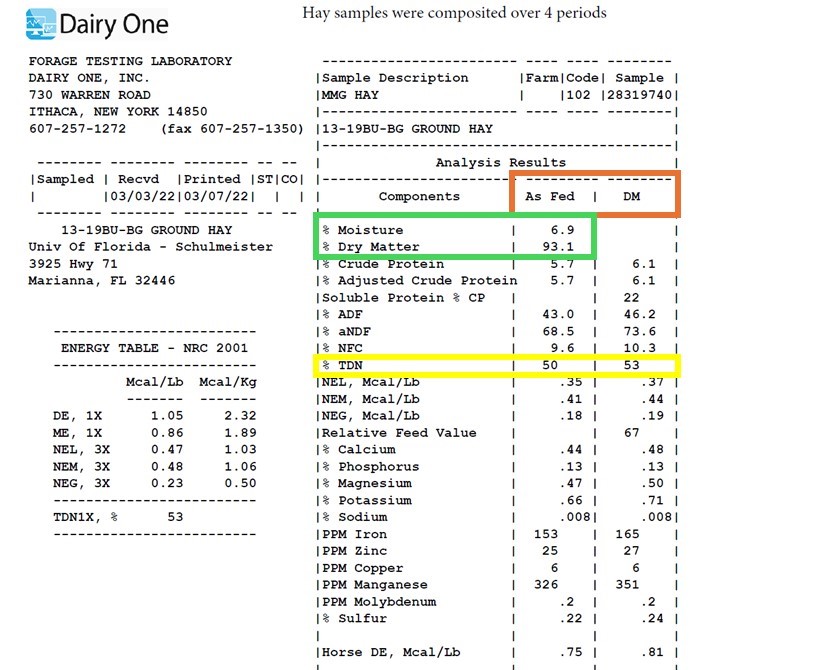It is very hot in the Florida Panhandle right now, but fall is coming. As fall creeps in, cattle producers will face the need to supplement their herds, so for most of us that means buying hay and other feeds, so let’s talk about the difference in dry matter vs. as fed nutritional values!
As cattle producers our minds are geared to thinking of things as is – meaning, if I purchase 100 pounds of feed and feed 100 pounds to my herd, they are getting 100 pounds of feed! Unfortunately, that is not the case. While you purchased 100 pounds, a percentage of that feed was water. That’s right – all feed, no matter how dry it seems, is by weight a percentage water. Understanding the difference between As Fed and Dry Matter feeding values will help increase the profitability of your management.
–
Water Content of Feed
First let’s establish an understanding that all feed (forage  or concentrates) has water in it. How much water, well that directly depends on the feed. Table 1 gives examples of the moisture content of common feeds. Typically, lush green forages are higher in water content than harvested feeds or concentrates. However, some by-product feeds can be deceivingly high in moisture content.
or concentrates) has water in it. How much water, well that directly depends on the feed. Table 1 gives examples of the moisture content of common feeds. Typically, lush green forages are higher in water content than harvested feeds or concentrates. However, some by-product feeds can be deceivingly high in moisture content.
–
As Fed Vs. Dry Matter
Feed analysis is reported in two ways: As Fed or Dry Matter. Figure 2 is an example of a feed analysis report. Notice that there are two columns reported. One is for As Fed and the other Dry Matter (DM). The DM column converts all feed values with the moisture removed. As Fed values are reported as the sample was received without drying. The main reason that feeds are converted to a dry basis is to provide fair comparison. No two cuttings of hay or batches of feed will have exactly the same moisture content, so when you take the moisture out you can then compare sample to sample fairly.
–
As-Fed represents the nutrients of that feed in totality. In other words, as you would feed it to the cattle, including the moisture/water weight. As-fed represents the feeds nutrients as it is delivered to the livestock, but what it does not do is consider the percentage of that feed that is water.
Dry Matter (DM) is reported by removing the moisture content of the feed and is reported per dry pound. The nutrients reported on a DM basis will always be denser or a higher percentage than the As Fed numbers. This is important because as the percentage of water per pound of feed increases, the total nutrients per pound decreases.
The calculation for converting feed and comparing dry matter to as fed are simple and well explained by Bryan Reiling, Extension Youth Livestock Specialist in his Article “Feed Dry Matter Conversions”.
–
Considerations for Purchasing
When purchasing feed and supplements it is always a great idea to break down those feeds on a cost/lbs. of dry matter. For example, if you are considering the cost of hay vs. silage you would break down each nutrient by cost per pound on a dry matter basis. Most commonly producers would need to compare the cost of crude protein (CP) and total digestible nutrients (TDN) per pound of dry matter before making a purchasing decision. After the cost comparison is made, remember to then convert the total feed needed back to As-Fed to determine the total pounds needed for each animal and/or the purchase as a whole.
–
Take Home Message
Feed is one of the top three expenses on every cattle operation. It is the little details that make the big difference. Understanding the difference between Dry Matter vs. As Fed feed values can play a key role in purchasing feed. There is no need to pay extra for water, and purchasing feeds on a cost per pound of dry matter based off nutrient values (%CP or %TND) is the most economical way to pay!
- Nutrient Cycling in Grazed Pastures - July 18, 2025
- Summer Mineral Consumption for Cattle on Pasture - July 11, 2025
- Hens in the Heat - July 11, 2025


